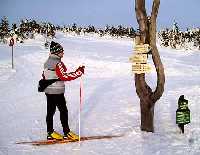Nejvyšší české hory i jejich podhůří jsou jedinečné svou polohou, svou historií a přírodou. Nejvyšší partie hor pokryté tundrou připomínají spíše krajiny Arktidy vzdálené odsud tisíce kilometrů. Níže na svazích hor najdete smrkové a bukové lesy a na loukách rozeseté horské chalupy. V údolích pak kouzelné potoky a řeky a kolem nich rušná i klidná horská střediska.
Velká část Krkonoš je chráněna národním parkem - a to na české i polské straně. Pro svou jedinečnost byly dokonce vyhlášeny biosférickou rezervací Unesco. Přesto najdete v horách i v podhůří mnoho příležitostí pro aktivní dovolenou. Od jara do podzimu si můžete vybrat nepočítaně značených cest pro pěší turisty i cyklisty. V zimě pak stovky kilometrů upravených tras pro běžkaře či řadu sjezdových tratí.
V horách i ve střediscích pod horami je vždy co vidět a co okusit.
KRKONOŠE - HORY ZÁŽITKŮ!
Search for: |
General | Geography | History | Nature- | Climate, weather | Nature conservation | Geology, geomorphology | Flora | Fauna | Tourism- | Tourist Information | Tourism | Outdoor sports | Sights | Celebrities- | Artists | Entrepreneurs | Sportsmen
About the region(found: 2 out of 95 records in category: About the region) The Krkonose Mountains are well known for their unsettled wheather conditions. Its typical oceanic character caters for moderate summers and precipitation-rich winters. Low 1: Natural avalanches very unlikely. Human triggered avalanches unlikely. Travel is generally safe. Normal caution advised. |











